Just an Irish guy on witchy adventure.🌱 Plant Enthusiast : 🎲 Dnd Lover : 🏳️🌈 Practising Homosexual 🥀 Working with Persephone
Don't wanna be here? Send us removal request.
Text
15 Day Crystal Spirit Devotional Challenge
This is inspired by @cardicoven ‘s plant spirit devotional challenge. I got permission to do this spinoff. This challenge is to help you bond with a crystal of your choice and its energy and spirit!

DAY 1: Introduction to the Crystal you’re choosing to focus this challenge on.
DAY 2: Research and share where this crystal is naturally located (mined etc)! If it’s mined in multiple countries, list them!
DAY 3: Research and share the Crystal/Mineral’s structure and formations. Does it naturally form in a cubic formation or something different! Get specific!
DAY 4: Research and share historical or ancient uses (if any). If it’s a newly discovered crystal, when was it discovered, and by who?
DAY 5: Do your best to create art inspired by the crystal you chose.
DAY 6: Research and share the Magical Correspondences!
DAY 7: Research and share folk tales, myths, or stories associated with the crystal! If there isn’t any pre-existing story, make your own (but be sure to mention it’s something you made up).
DAY 8: Research and list deities and spirits associated with the crystal.
DAY 9: Share a tarot or oracle card YOU feel embodies this crystal’s energy!
DAY 10: Create a sigil to invoke the power of this crystal’s energy/spirit. You can trace this sigil on the crystal with your finger to activate its strongest power or your connection with it.
DAY 11: Meditate or focus on the crystal for five minutes. Then journal afterwards how it went!
DAY 12: Write about your current relationship with the Crystal and its spirit!
DAY 13: Personal goals when working with this crystal spirit!
DAY 14: Research ways to safely cleanse the crystal without damaging it. (Is it sun safe, water safe, salt safe, etc)
DAY 15: Exercise conclusion, main takeaways, and final overview!

76 notes
·
View notes
Note
Heyyy I was wondering if I could make a crystal version of your plant ally devotional exercise challenge? 💗
I think thats a wonderful idea and can’t wait to see how it goes 💜
3 notes
·
View notes
Text
🌿Plant Spirit Devotion: Herbal Altars
So this is alittle unorthodox but I've been keeping/tending an Altar specifically for my current Herbal Ally, atleast for the duration of my active devotional to that Plant Spirit (my post about Plant Spirit Devotionals). Currently my altar is set up for Rosemary pictured below. The Purpose of these altars is not to worship or revere the Spirit in the same way that my Persephone Altar exists to venerate the goddess. In my mind a Herbal Altar exists as a dedicated space for the spirit which acts as a reminder of the spirit throughout the day, while the aromatics of the Herbs themselves and the general energy of the Plant is allowed to suffuse the area.

My Rosemary Altar pictured above contains the following:
Fresh Rosemary: Personally I think the most important thing on a Herbal Altar should be the plant itself, ideally a living plant but when that is unavailable the best alternative is fresh plant matter.
Dried Rosemary: Failing fresh plant matter, dried herbs can work just as well.
Rosemary Essential Oil: An essential oil or similar product made using the plant represents the myriad forms the Herbal Ally can take in your Practice.
A Herbal Flash card for Rosemary: This card not only has beautiful artwork depicting the Herb but on the opposite side contains information revolving around Rosemary's mundane and magical properties allow with a short botanical dossier. This is a representation of the Plants properties and what you can learn from it.
An associated Tarot/Oracle card: In My case I like to have a representative Tarot card for my Herbal Allies, I use the Bottanical Deck by Jessica Bott which happens to have a Card for Rosemary.
A tea light candle dressed in Rosemary oil and dried Rosemary: A representative of the Herb role in rituals, and in my broader practice. I plan on burning this on the last day of my devotional.

#🌿 Plant Spirit Devotion#herbal magick#plant spirit#plant ally#herbal ally#paganism#pagan#paganblr#green witch#witchcraft#witchblr
290 notes
·
View notes
Text
🌿Rosemary Devotional - Day 5: Art Inspired by or incorporating Rosemary.
Below are some pieces of artwork I've been able to find inspired by or incorporating Rosemary. If anyone knows any others, it would be amazing if you could reblog with the art pieces and links to their artists.

Image by Fez Inkwright from their book 'Folk Magic and Healing. An unusual history of everyday plants' : Website : Instagram

#🌿 Plant Spirit Devotion#🌿 Rosemary Devotional#herbal magick#plant spirit#plant ally#herbal ally#paganism#pagan#paganblr#green witch#witchcraft#witchblr
6 notes
·
View notes
Text
🌿Rosemary Devotional - Day 4: Mundane Properties.
Culinary Properties. Rosemary is one of the most prized herbs used in cooking, especially in Mediterranean cuisine. It is used to flavour various dishes, both sweet and savoury, but is most popular in dressings for meats. Rosemary is found in the French herb blends bouquet garni and herbes de Provence as well as in seasoning blends for lamb, roasted vegetables, and various Mediterranean dishes. The leaves have a bitter taste which compliments fatty foods like lamb and oily fish. Rosemary leaves contain about 1 to 2.5% essential oils and the main flavour of rosemary comes from the aromatic compounds “eucalyptol” and “alpha pinene” which are described as camphor-like and piney respectively.
Narbonne honey from France mostly comes from bees feeding on rosemary blossoms.
Use in Beauty and Cosmetics. Rosemary flowers and leaves contain an essential oil which has a strong aromatic fragrance, making it a popular ingredient in perfumery, cosmetics, hair products and incense burners.
Rosemary has strong antioxidant properties and contains iron, calcium, and phytonutrients so it is added to hair care products to provide hydration and protection from sun damage. Medicinal Properties. The herb has been hailed since ancient times for its medicinal properties. Rosemary was traditionally used to help alleviate muscle pain, improve memory, boost the immune and circulatory system, and promote hair growth and is a good source of iron, calcium, and vitamin B-6. The leaves and flowers of rosemary can be used to make a tea, thought to relieve headaches, colic, colds, and depression. Rosemary also has antibacterial and antifungal properties.
It was used in traditional European herbal remedies for a variety of ailments, including wounds, eczema, poor appetite, and asthma. Modern research have shown that rosemary may improve a person’s concentration, performance, speed, and accuracy and, to a lesser extent, their mood. Other studies suggest that Rosemary may slow brain aging and could possibly protect against macular degeneration. Rosemary can affect the activity of some medications, including:
Anticoagulant drugs: These include blood-thinning medications, such as Warfarin, Aspirin, and Clopidogrel.
ACE inhibitors: These are used for treating high blood pressure. They include lisinopril (Zestril), fosinopril (Monopril), captopril (Capoten), and enalapril (Vasotec).
Diuretics: These increase the passing of urine and include hydrocholorothiazide and furosemide (Lasix).
Lithium: This is used to treat the manic episodes of manic depression. Rosemary can act as a diuretic and cause lithium to reach toxic levels in the body.

Sources: McCormick Science Institute : Kew : Medical New Today : Herbalist's Primer by Anna Urbanek
#🌿 Plant Spirit Devotion#🌿 Rosemary Devotional#herbal magick#plant spirit#plant ally#herbal ally#paganism#pagan#paganblr#green witch#witchcraft#witchblr
16 notes
·
View notes
Text
🌿Rosemary Devotional - Day 3: Cultivation, Foraging and Preparation.
Cultivation. Since it is attractive and drought-tolerant, rosemary is used as an ornamental plant in gardens especially in regions of Mediterranean climate where it is considered easy to grow and pest-resistant. Rosemary prefers sandy, well-draining soil, which is necessary for its health, but even then it is hard to germinate and slow growing. It thrives in maritime conditions. but is usually frost tender. In colder climates, grow it in containers and move indoors to overwinter. Prune it often to promote healthy growth. Rosemary can grow quite large and retain attractiveness for many years, can be pruned into formal shapes and low hedges, and has been used for topiary. Foraging and Preparation. Harvest twigs to use fresh or hang them and air dry, then store in an airtight container to preserve the aroma. Gather no more than a third of the shrub at the time, allowing plant to regrow before net harvest. As the aroma and flavour come from volatile oils, fresh rosemary is preferred in all cases; it loses the potency in time.

Sources: Herbalist's Primer by Anna Urbanek : iNaturalist
#🌿 Plant Spirit Devotion#🌿 Rosemary Devotional#herbal magick#plant spirit#plant ally#herbal ally#paganism#pagan#paganblr#green witch#witchcraft#witchblr
26 notes
·
View notes
Text
🌿Rosemary Devotional - Day 2: Native Habitat.
Rosemary is native to the dry scrubland of the Mediterranean region (southern Europe, Asia Minor, and North Africa) but is also reasonably hardy in cooler climates (where it is grown as an annual). Rosemary flowers in the summer but can be in constant bloom in warm climates, and in some climates, can live as long as 30 years. Native to: Albania, Algeria, Baleares, Bosnia and Herzegovina, Corse, Croatia, Cyprus, East Aegean Islands, Egypt, France, Greece, Italy, Libya, Montenegro, Morocco, North Macedonia, Portugal, Sardinia, Serbia, Sicily, Slovenia, Spain, Tunisia, Turkey Introduced to: Azores, Bermuda, Bulgaria, Canary Islands, Cap e Verde, Crimea, Great Britain, Kriti, Madeira, Mexico Central, Mexico Southwest, Texas, Trinidad-Tobago
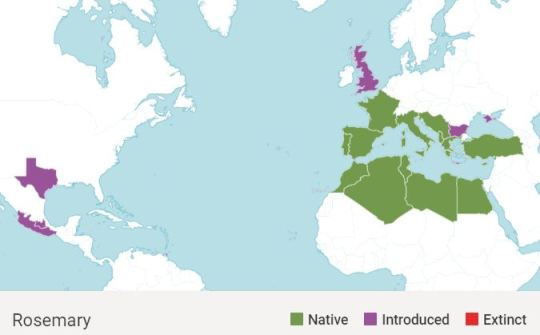

Sources: The McCormick Science institute : Map from Kew Gardens
#🌿 Plant Spirit Devotion#🌿 Rosemary Devotional#herbal magick#plant spirit#plant ally#herbal ally#paganism#pagan#paganblr#green witch#witchcraft#witchblr
7 notes
·
View notes
Text
🌿Rosemary Devotional - Day 1: An introduction to Rosemary.
Rosemary is an aromatic evergreen shrub with needle-like leaves, valued as a flavouring herb. It improves digestion and brain functions, and is associated with remembrance and fidelity.

Botanical name: Salvia rosmarinus Description: A shrub of an upright or trailing form. Twigs are covered in brown bark and grow evergreen needle-shaped leaves, green above and silvery white below, covered in dense, wooly hairs. Some cultivars have striped leaves. Flowers range from white to pink to purple to blue. When touched or bruised, the plant exudes woody, mustard-like aroma. The flavour of the leaves is bitter, complementing many savoury dishes.

Sources: Herbalist's Primer by Anna Urbanek : Picture from RBG Kew credited to Ellen McHale
#🌿 Plant Spirit Devotion#🌿 Rosemary Devotional#herbal magick#plant spirit#plant ally#herbal ally#paganism#pagan#paganblr#green witch#witchcraft#witchblr
13 notes
·
View notes
Text

Ares, revolution’s king,
Athena, the mechanic’s sting,
Warmonger and Muckraker we plead,
Praying, demanding, fighting, a need,
For blue skies over Palestine.
Ares, who wins regardless who bleeds,
Athena, the bombshells and the path they leave,
Return to them peace and olive trees,
Let this genocide be no more,
And Hades need not wait by the door.
Artists Against Apartheid (art from poster pack 1) | Esims for Gaza | Care for Gaza
87 notes
·
View notes
Note
hi!! could you share any of your experiences interacting with persephone? or how has it felt to communicate with her? or even just fun anecdotes. ive given her an offering and im so happy to worship her... but god theres so little info or people talking about her!!!
Hey! So thanks for the lovely question, its great to hear that your reaching out to Persephone and are looking into worshipping her. I've been working with Persephone for around 3 years, giving weekly (often daily) offering and have maintained an altar space for her throughout that time. I say this not to boast or seem all knowing on the topic but to give some small context on my practice with her. Like many others my practice and worship of Persephone varies with the seasons, I feel her most strongly in Spring and Summer. During this time when light her candle I feel her presence, almost in that way when a Parent/Mentor/Guardian looks in your direction and you feel their eyes on you. When I leave offering during these months, I often experience feedback sometimes emotional, rarely I'll hear an affirmation, 'Thank you' or 'how thoughtful' kinda thing. When I call for her assistance in ritual I feel her behind me, sometimes guiding my hand, or I'll smell/taste something she advises for the ritual, only for the feeling to pass when I lay my hands on the herb/oil/item suggested. When it comes to divination she a dedicated card in my Tarot the 10 of Pentacles (which in my deck is the Pomegranate 10 of Crops, I use the Bottanical Deck link) and in my experience she's always happy to make it appear when she has something to say during Divination. In Autumn and Winter my experiences with her is very different, she feels distant, less patient, she's in the Underworld and has stuff to do. I don't feel her when I light my candles or leave small offerings. Only when I Invoke her and ask for her help in ritual do I feel her presence, its powerful, not stern per se but business esc, she's there to help and her time is not to be wasted. During this time I only invoke her when I really need her, most often in death work, or partially important banishings/protections and I always have a sizable offering at this time. That's not to say Persephone is not comforting or compassionate towards me in the colder months, her attention is elsewhere, and her responsibilities are with the dead.

That's all little heavy so here's a fun Anecdote. A few Years ago, myself and some witchy friends had a Party, there was plenty of drinking and debauchery (we were celebrating a friends bad break up). During a lull in the evening we pulled some cards and did some Tarot, nothing serious just good fun freaking out a few non-witchy friends, nevertheless Persephone had a word or two to share on the breakup, and while I don't remember much of it, it consisted of pointing out the Guys flaws and highlighting my friends strengths. After we put the cards away my friend asked how she should thank Persephone for her insight, I said leave her a wee offering, pour a shot out for her outside. My friend did so and said the following 'Thank for your wisdom Lady Pomegranate', before going back inside and passing out. I guess it's the thought that's counts.

Just gonna finish this off with a small list of recommended Reading since Anon is just starting out, and hopefully it might be useful. I'll link to Goodreads, but you should be able to find copies of these online somewhere if you try to. o Persephone's Pathway by Jennifer Heather: link : a wonderful exploration of Persephone from a modern pagan perspective but not without flaw. (my review) o Greek Religion by Walter Burkert: link : Currently making my way through this, it's academic and a heavy read but so far enlightening. o Old Stones, New Temples by Drew Campbell: link : an older book about Hellenic reconstructionism, reading it atm, so far its heavy but good. o Underworld Gods in Ancient Greek Religion by Ellie Mackin Roberts: link : On my reading list, 'This volume presents a case for how and why people in archaic and classical Greece worshipped Underworld gods.' o Hellenic Polytheism: Household Worship by LABRYS: link : I haven't got around to this yet but it's comes highly recommended. Hope this helps, and thanks again for the ask.
46 notes
·
View notes
Text
🌿Plant Spirit Devotional: 15 Day Exercise
Here's my concept for a method to facilitate bonding with a Plant Spirit or Herbal Ally over the course of a month. Obviously this practice takes far longer than a month to create a lasting bond with a plant spirit but hopefully this exercise helps provide some structure to the practice of bonding with a Herbal Ally. Feel free to use this outline yourself or modify it to your own needs.
15 days of Plant Spirit Devotion. Day 1: Introduction to the chosen plant. Day 2: The plants native habitat. Day 3: Cultivation, Foraging and Preparation. Day 4: Mundane properties (Culinary, Medicinal, Poisons etc). Day 5: Art inspired by / incorporating the chosen plant. Day 6: Magical correspondences. Day 7: Folk names and their origins. Day 8: Folklore and associated myths. Day 9: Deity / Spirit associations. Day 10: Plant's role in ritual: Cultural and Spiritual Significance. Day 11: Tarot / Oracle associations: Card spotlights. Day 12: Personal Sigil for the Plant Spirit. Day 13: Current Relationship with the Plant Spirit. Day 14: Personal goals when working with the Spirit. Day 15: Exercise conclusion, Take-aways and final overview.
My current plan with this exercise is to complete it each month for a different plant spirit / herbal ally, starting with Rosemary during February. Generally my plan is to spend the first half of the month bonding with the herb and researching it and the latter half of the month completing this exercise.

This Exercise was inspired by this post: link by @noctivague about a 15 day deity devotional. Thanks for the amazing idea!
#🌿 Plant Spirit Devotion#herbal magick#plant spirit#plant ally#herbal ally#paganism#pagan#paganblr#green witch#witchcraft#witchblr
558 notes
·
View notes
Text

A guide to worship of Persephone- cheat sheets
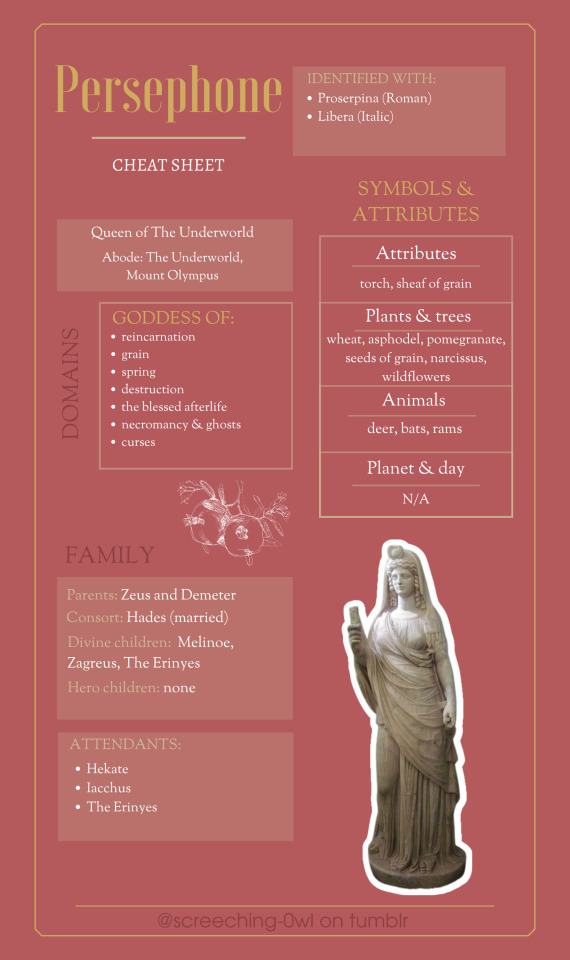
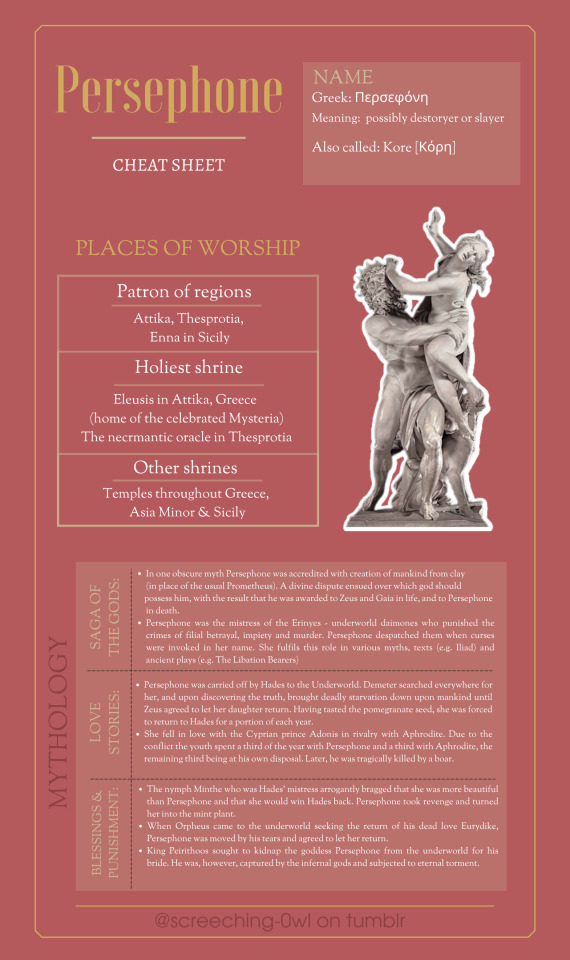
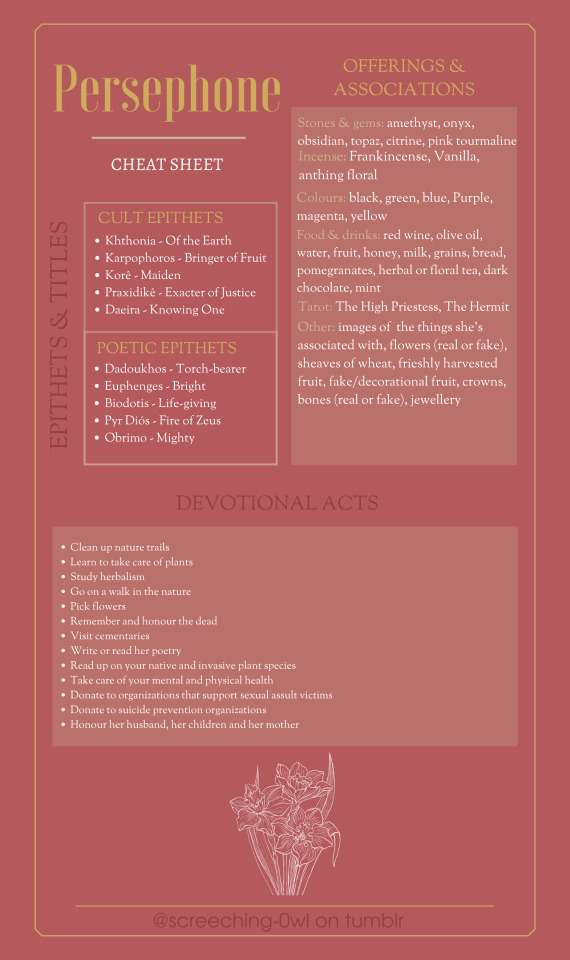
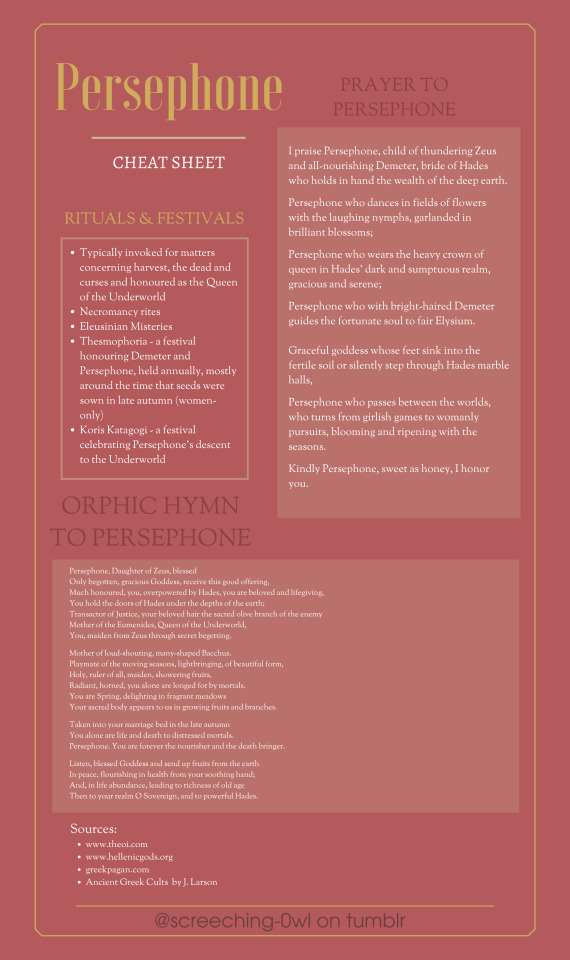
Hellenic cheat sheets
If you like my content consider supporting me on: https://ko-fi.com/screeching0wlet
#persephone#persephone worship#persephone deity#persephone goddess#persephone devotee#persephone devotion#paganblr#paganism#pagan witch#hellenic pagan#hellenic gods#witchblr#witchcraft#greek mythology#mythology
2K notes
·
View notes
Text
Hades and his aid to heroes in greek myths
Out of all the gods in the greek pantheon, Haides has the strongest reputation for being closed off and uninvolved with humans. After all, he lives in the underworld and rarely, if ever, leaves his realm.
However, after thinking about greek mythology obsessively (as I always do), I realized that there is a pattern of Hades helping heroes/mortals. He doesn’t help them directly like Athena or Hermes do because he’s always in the underworld, but he does aid mortals even when there’s no obligation for him to do so. Here are some examples:
Hades lending his helmet of invisibility to Perseus so he can slay the gorgon
Pseudo-Apollodorus, Bibliotheca 2. 36 - 42 (trans. Aldrich) (Greek mythographer C2nd A.D.) :
“These Nymphai had in their possession winged sandals and the kibisis, which they say was a knapsack.--Pindaros and Hesiodos in the Shield of Herakles, describe Perseus as follows : ‘The head of a terrible monster, Gorgo, covered all his back, and a kibisis held it.’ It is called a kibisis because clothing and food are placed in it.--They also had the helmet of Haides. […] Perseus then placed the head in the kibisis and headed back again, as the Gorgones pursued him through the air. But the helmet kept him hidden, and made it impossible for them to identify him.”
Hades giving his hound to Heracles so he can fulfill his labors and letting him free his prisoners
Pseudo-Apollodorus, Bibliotheca 2. 125 (trans. Aldrich) (Greek mythographer C2nd A.D.) :
“Herakles asked Plouton (Pluton) [Haides] for Kerberos (Cerberus), and was told to take the hound if he could overpower it without using any of the weapons he had brought with him."”
Pseudo-Hyginus, Fabulae 79 (trans. Grant) (Roman mythographer C2nd A.D.) :
“When Hercules came to lead out the three-headed dog, they [Peirithoos and Theseus, trapped in the underworld] begged his promise of protection. He obtained the favor from Pluto [Haides], and brought them out unharmed.”
Hades and Persephone allowing Orpheus to leave the underworld with his deceased wife
Pseudo-Apollodorus, Bibliotheca 1. 14 (trans. Aldrich) (Greek mythographer C2nd A.D.) :
“When his [Orpheus'] wife Eurydike (Eurydice) died from a snake-bite, Orpheus descended into Haides' realm with the desire to bring her back up to earth, and persuade Plouton (Pluton) [Hades] to release her. Plouton promised to do this if on the return trip Orpheus would not turn round before reaching his own home. But he disobeyed, and turned to look at his wife, who thereupon went back down again.”
Ovid, Metamorphoses 10. 8 ff (trans. Melville) (Roman epic C1st B.C. to C1st A.D.) :
“[…] the queen [Persephone] and he whose sceptre rules the underworld could not deny the prayer, and called Eurydice.”
Hades and Persephone granting Odysseus’ wish
Homer, Odyssey 10. 135 ff (trans. Shewring) (Greek epic C8th B.C.) :
“Then I called to my comrades and bade them flay and burn the sheep that lay there slain with the pitiless bronze, and to make prayer to the gods, to mighty Hades and dread Persephone.” (Immediately after this, Hades and Persephone answer Odysseus’ prayer)
Bonus: Hades lends Hermes his helm of invisibility so he can protect himself while battling the giants
Pseudo-Apollodorus, Bibliotheca 1. 34 - 38 (trans. Aldrich) (Greek mythographer C2nd A.D.) :
“Hermes, who was wearing the helmet of Haides, killed Hippolytos in the course of the battle, and Artemis killed Aigaion (Aegaeon).”
My thoughts
So if Hades answers prayers, lets other gods and mortals borrow his most valuable weapon, and even breaks his own rules (no one can leave the underworld) to grant other people’s wishes, how can we call him closed off? From this pattern of behavior, it seems like he’s extremely caring and generous . We have to kill the myth that chthonic deities are unresponsive and apathetic.
Here’s an article about Hades’ worship for everyone who wants to keep reading about this topic
109 notes
·
View notes
Text
Persephone Deity Guide
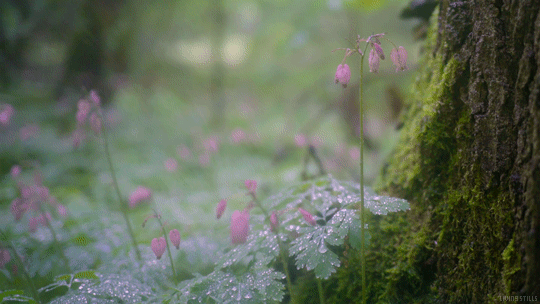
Who is Persephone?
Known as Prosperina to the Romans, Persephone is a Greek goddess of spring and the queen of the underworld, ruling alongside Hades. Due to her mythology, in antiquity, she is closely related to all aspects of womanhood and female initiation, including girlhood, marriage, and childbearing. (This is an ancient view of what womanhood means and does not reflect my personal views on the topic).
Parents and Siblings
Persephone’s parentage varies depending on who you ask
Demeter (her mother in the most popular variation)
Zeus (father in the most popular variation)
other variations include:
Styx (and Zeus)
Rhea (and Zeus)
Posiden (and Demeter)
She has no full blood siblings, but has plenty of half-siblings from both Demeter and Zeus, most notably:
Arion (brother)
Corybas (brother)
Plutus (brother)
all from Demeter, and
Apollo
Artemis
Athena
Dionysus
Heracles
Perseus
and many more from Zeus.
Lovers or Partners
Hades
Adonis (in some tales, in others he is more of an adoptive son to her; in some tales, he’s both. Greek gods, am I right?)
Children
In Orphic myth her children are
Melinoe
Zagreus (later turned Dionysus)
The Erinyes
Epithets
Kore, Kora, or Cora - the maiden
Nestis - the fasting one
Despoina (literally "the mistress of the house") in Arcadia.
Hagne, "pure", originally a goddess of the springs in Messenia.
Melindia or Melinoia (meli, "honey"), as the consort of Hades, in Hermione.
Malivina
Melitodes
Aristi cthonia, "the best chthonic".
Praxidike, "subterranean queen. The Eumenides' source [mother], fair-haired, whose frame proceeds from Zeus' ineffable and secret seeds."
Agauē, “venerable”
Arrētos, “she who must not be named”
As a vegetation goddess, she was called:
Kore Soteira, "the savior maiden", in Megalopolis.
Neotera, "the younger", in Eleusis.
Kore of Demeter Hagne in the Homeric hymn.
Kore memagmeni, "the mixed daughter" (bread).
Demeter and her daughter Persephone together were usually called:
The goddesses, are often distinguished as "the older" and "the younger" in Eleusis.
Demeters, in Rhodes and Sparta
The thesmophoroi, "the legislators" in the Thesmophoria.
The Great Goddesses, in Arcadia.
The mistresses in Arcadia.
Karpophoroi, "the bringers of fruit", in Tegea of Arcadia.
Notes
Persephone’s most popular story, the abduction of Persephone, is possibly derived from the ancient Sumeria myth of Ereshkigal, goddess of the underworld who was abducted by Kur, the primeval dragon of Sumerian mythology, who forced her to become ruler of the underworld against her will. Keep in mind that there are many versions and interpretations of this myth.
Another story about Persephone involves her interaction with a Nymph named Minthe, who used to be one of Hades’ lovers. Minthe boasted that she was more beautiful than Persephone and would win Hades back. Persephone didn’t take kindly to this boasting and stomped Minthe into the ground, turning her into a mint plant.
Other popular stories are Adonis and Persephone, one creation myth, as well as many more.
It’s possible that Persphone is an old Cthonic local deity of agricultural communities that was absorbed into Greek mythos.
Persephone played a part in many different festivals and rituals in the Greek and Roman world. Many festivals were held in which people would reenact her abduction and her being found again by Demeter. In Syracuse, there would be an annual sacrifice of small animals and a public drowning of bulls.
Among the cults dedicated to Persephone, the largest one was located in Sicily and Southern Italy.
For her connection to the Underworld, Persephone is often mentioned in curse tablets and on gold leaves that were buried with people who had how to act in the afterlife inscribed on them.
Modern Deity Work
Correspondences
Due to being a popular deity that was widely worshiped, the ancient correspondences of Persphone vary. Some symbols and attributes were more popular than others, and some were localized or cult-specific. Regardless, any traditional or historic correspondences will be marked with a (T).
Rocks/Stone/Crystals
Ruby
Quartz
Pink Tourmaline
Herbs/Plants
Poppies
Pomegranates
Corn
Grain
Asphodels
Willow
Animals
Pigs
Roosters
Symbols
Scepter
Torch
Festivals and Rituals
Thesmophoria is a three-day festival celebrated by most of the Greek world; though the female cult of Demeter and Persephone were known to celebrate it more. This festival was probably celebrated around October-November. In some places, this festival or certain aspects of it were exclusive to women.
Chthonia, where four old women would be chosen to sacrifice four heifers with sickles. This festival honored Demeter in connection to Persephone.
Offerings
Honey (T)
Art (statues, pinakes, etc) (T)
Pomegranate (full fruit, the seeds, or juice)
Flowers, especially wild spring flowers!
Floral scents or like perfumes, oils, or incense
Any of the items or depictions of the items listed above
Wine
Bones
Chocolate (some say specifically dark chocolate)
Acts of Devotion
Dancing to a song that reminds you of her (T)
Creating any art that reminds you of her (T)
Tend to wildflowers or your garden if you have one, or even houseplants.
Celebrate the festivals/holidays mentioned above
As always, your personal correspondences when interacting with a deity will mean much more than anything you find online, but this isn’t a bad place to start!
References and Further Reading
Persephone - Mythopedia (they also have a pretty huge reference list so please go take a peak!)
Persephone and the Seasons - Hellenic.org.au
Hymn for Persephone by Sappho (vis Sacredtexts)
Persephone - Theoi Project
Persophone - World History
(please message me if you are a follower or devotee of Persephone and would like to be added as a resource that someone could reach out to in regards to her!)
395 notes
·
View notes
Text
🥀Book Review: Persephone's Pathway: Wisdom, Magick & Growth by Jennifer Heather
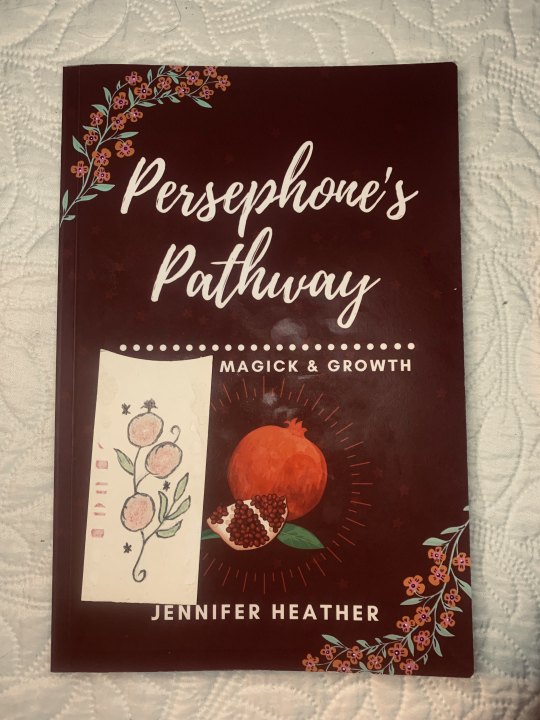
Full Title: Persephone's Pathway: Wisdom, Magick, Growth Author: Jennifer Heather Published by: Heather Publishing (seemingly self published) 2020 Good Reads: Link My Quick Review: ⭐⭐⭐⭐ (4/5) stars. Persephone’s Pathway which while flawed and at times meandering is perhaps the best resource available for the modern pagan worshipping or working with Persephone and I wholly recommend it. Official Blurb: Persephone's Pathway is one of balance and duality; embrace the dual goddess archetype of Underworld Queen and Spring Maiden in order to achieve harmony. This book shares the wisdom of Persephone, along with spells and rituals to help you in your daily life. Shadow work exercises encourage you to work with the Underworld aspect of the Dark Goddess, whilst flower magick celebrates the joy and gentleness of the Spring Goddess. Blend the dark and light aspects together to experience how they shine a light on each other in this celebration of wholeness and authenticity. Personal Reason for Purchasing: Was looking for a pagan/witchy perspective on Persephone and stubbled across this one. (Bought from Amazon UK)

Overview of the book's contents. Introduction: A solid introduction, focusing on what the purpose of this book will be, and the author’s goals in writing it, namely ‘an exploration of the mythology and Symbolism surrounding Persephone, along with chapters dedicated to a facet of what she can teach us’, ‘both a collection of information and tribute to her’. Chapter 1: 'Who is Persephone': Introduction to Persephone, her role, dual nature, The Eleusinian mysteries, possible connections to Erishkegal (a mesopotamia goddess originating 4000 BC), and of course the Homeric Hymn to Demeter. Chapter 2: 'Historic Origins': An exploration of the genesis of Persephone in Mythology, through to the Evolution of her story in present day literature. (A personal highlight). Chapter 3: 'A Myth Retold': A modern retelling of the hymn to Demeter by the author. Chapter 4: 'Symbolism': An exploration of the artefacts associated with Persephone, both modern and ancient, the creation of a unique glyph/sigil for Persephone and an extensive and detailed discussion of association/correspondences, some ancient, some contemporary and lastly her common epithets. Chapter 5: 'Creating an Altar': A collection of suggestions and guidelines on creating your own altar for Persephone and common offerings to gift the Goddess. Chapter 6: 'Persephone Magick: Begins with a basic beginners to magickal practice, followed by a recipe for a Persephone Anointing oils, a guide to connecting to Persephone, an innovation and an adaption of the Orphic Hymn to Proserpina.

The Seeds of Persephone A collection of chapters surrounding what the Author considers to be the six core aspects/values which Persephone embodies. Seed 1: 'Union': Focuses on Shadow-work, divine alignment for body and Spirit union, and includes a spell for Spiritual union of lovers, guidance surrounding meditation, shadow-work rituals, and a recipe for a love attraction oil. Seed 2: 'Balance': Begins with a discussion of how to, and the importance of maintaining balance in one’s life, including a meandering discussion of grounding, living with the seasons, incorporating nature into your life, meditation, seasonal altars, self-care, massage, and yoga. Lastly it includes recipes for a Persephone Beauty Elixer’ cream/lotion, a medicinal tonic, a spell for resolution, and a spell for making a decision. Seed 3: 'Intuition': Looks at ways to develop one’s intuition, including an outline for a Persephone focused Lithomancy technique (10 planetary stones, 6 Persephone stones (named for each of the author’s ‘Seeds’: Fertility, Justice, Balance, Union, Sovereignty and Intuition), three tarot spreads and the script for a guided meditation. Seed 4: 'Sovereignty': Is a discussion of [personal Sovereignty, and self-esteem, with journal prompts. Guidance on enchanting a power talisman, and a spell for protecting personal boundaries. Seed 5: 'Justice': Focuses heavily on Persephone in her Queen of the Underworld Aspect, touching on several myths in which she acted as a Purveyor of justice, (Orpheus and Psyche, and a discussion on Trust in regards to the Goddess. Followed by Several spells for truth telling, reflection on behaviour and fair resolutions. Seed 6: 'Fertility': Focuses on Persephone's Spring/Maiden Aspect. Followed by a discussion of Maiden goddesses, Flower Magick, creating Floral elixirs, cleansing sprays, a flower bathing ritual, and spell jars/Witch’s bottles. Followed by the Associations/correspondences and finally a script of a guided meditation, to meet Persephone in her Spring Aspect. Appendix: The Orphic hymn to Proserpina, translated by Taylor Thomas 1792.

Personal Thoughts and Review. I’m conflicted about this book. The first half is an excellent primer on Persephone and including her into one’s personal practice however, the second half the ‘Seeds of Persephone’ are at times Meandering, unfocused and clumsy, but there are jewels among the ramblings.
The book appears to be self published, so I’m inclined to be kinder to the Author than I would otherwise be; however, Persephone’s Pathway could really use reformatting (text justified etc), and would benefit immensely from an informed and passionate editor. Nevertheless this book is an excellent edition to the libraries of those of us who work with Persephone.
Aspects in detail. General content: The first half goes over a lot of content around Persephone, in some detail and is appropriately referenced through allowing the reader to research further. The Second half (the Seeds) is a mixed bag and approaches certain subjects extremely casually, namely Shadow-work and herbal medicine. Persephone’s correspondences: Primarily contained to Chapter 4, the Correspondences are in depth, reference and diverse. However, there are inaccuracies, the most obvious is a mention of Corn/Maize being cut as a part of the Eleusinian Mysteries. As a New World crop Corn was not in ancient Greece at the time and as such has no historical connection to the Mysteries. From my own understanding the crop cut during the Mysteries was likely Barley, a grain though to have great significance to the Eleusinian Mysteries as a part of the hallucinogenic cocktail thought to be drunk by initiates, barley is also part of the offering given by Oddyseus to summon Persephone (“first with milk and honey, then with sweet wine, then with water; and sprinkle white barley-meal above”). Rituals and Spells: It’s Always interesting to see another practitioner's approach, and covering a very broad scope although, I wish they were indexed since they appear throughout the book. Origin Myth retelling: An interesting retelling, possibly my favourite version, however it is not without flaws. Guided Meditations: Enjoyable and Interesting, these scripts approach many aspects of Persephone’s Mythos. Journaling Prompts: These appear seemingly at random in the latter half of the book, but are nevertheless thought provoking. Recommended Reading: While good to see, it is worthy of note that none of these books reference Persephone, Hellenic Polytheism, or Shadow-work. Which are the topics I would like to see additional material given some of my concerns with the book itself. Bibliography: Extensive and good practice.
The Seeds in Detail. Given their significance to the book I’ll review these chapters separately: Union: a clumsy chapter whose advice on Shadow-work is surface level and possibly dangerous for a beginner or someone who is mentally vulnerable. But this chapter does handle the topic of Love workings with the required levity. Balance: Waffling and honestly feels like filler, of the seeds this one is disappointing and feels like lost potential. Intuition: a major highlight of the book, a detailed exploration of Lithomancy, well written and thought provoking. Sovereignty: A good chapter, if a little long winded. Justice: Spectacular, discussion of Queen Persephone and of how to connect to the Underworld Aspect. A personal highlight. Fertility: An excellent close to the book but desperately needs reformatting.
Final Thoughts. I wholly recommend this book especially as a gateway into working with or worshipping Persephone. Despite its flaws, it is the best resource I’ve found on Persephone from a pagan/witch perspective, and my practice is better for reading it.

#🥀Book Review#book review#persephone#persephone worship#persephone deity#persephone goddess#persephone devotee#persephone devotion#paganblr#paganism#pagan witch#hellenic pagan#hellenic books#hellenic gods#pagan books#witchblr#witchcraft#witch book#spirituality#shadow work#greek mythology#mythology#gay witch#gay pagan
90 notes
·
View notes

